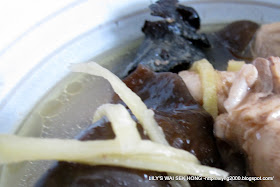My sisters have always told me that i take too much upon myself in whatever i do, and they are absolutely right. And, do i learn???? No! Same old me, repeating my habits and trying to do too much. Like last saturday, i had a potluck to go to and not satisfied with just bringing one kind of kuih, decided to make another one at the eleventh hour. See, what happened to the most delicious kuih made, it was shabbly cut cos it was not cold enough and there was not enough time to do a good job. I hate myself for that but do you think i will make kuih in a hurry again, you guessed right, i will.
Ingredients:
Rice Layer:
1 1/2 cup glutinous rice - washed and soaked
100 ml thick coconut cream
Thin coconut milk - enough to cover the rice
1 tsp kosher salt
2 pieces pandan leaves
1 tsp dried bunga telang - reconstitute with 1 tbsp hot water and a drop of vinegar
Topping:
3 large eggs
300 ml thick coconut milk
1/4 tsp salt
2 tbsp tapioca starch
1/2 cup unbleached all-purpose flour
3/4 cup sugar
Method:
Put soaked glutinous rice into the rice cooker and enough thin coconut milk to just covering the rice. Add salt and pandan leaves.
Press the cook function and as soon as the rice is cooked, discard the pandan leaves and pour in the thick coconut cream. Close the lid and leave on warm for 10 minutes for the coconut cream to marry into the rice.
In the meantime, mix the ingredients in a microwave-safe bowl and microwave on high for 1 minute and stir. Continue to cook for another 1 more minute. The mixture should still be runny.
Remove rice from the rice cooker and put it in a greased 9 inch cake pan and pressed the rice down. Sprinkle the coloring from the bunga telang on to the top of rice. If you like a marbled look, then you would have to stir in the color to the rice and then press down.
Put the rice to steam for 5 minutes, then pour in half of the topping. Steam the topping until cooked, then using a fork, roughen the surface with a fork before pouring in the rest of the topping. Steam on medium heat until cooked and done. Do not use high heat - patience will rewarded with a smooth topping.
When done, leave kuih to cool before cutting.
Serves





















































